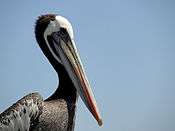Peruvian pelican
The Peruvian pelican (Pelecanus thagus) is a member of the pelican family. It lives on the west coast of South America, breeding in loose colonies from about 33.5° in central Chile to Piura in northern Peru, and occurring as a visitor in southern Chile and Ecuador.[2]
| Peruvian pelican | |
|---|---|
| Scientific classification | |
| Kingdom: | Animalia |
| Phylum: | Chordata |
| Class: | Aves |
| Order: | Pelecaniformes |
| Family: | Pelecanidae |
| Genus: | Pelecanus |
| Species: | P. thagus |
| Binomial name | |
| Pelecanus thagus Molina, 1782 | |
| Synonyms | |
| |
These birds are dark in colour with a white stripe from the top of the bill up to the crown and down the sides of the neck. They have long tufted feathers on the top of their heads. It was previously considered a subspecies of the brown pelican (Pelecanus occidentalis). The Peruvian pelican is considerably larger, ranging from about 5 to 7 kg (11–15 lb) in weight, 137 to 152 cm (4.5–5.0 ft) in length and with a wingspan of about 228 cm (7.5 ft).[2] Compared to the brown pelican, it also has proportionally longer crest feathers, as well as differences in the colours of the gular pouch, beak, scapulars and greater wing coverts.[2]
The main breeding season occurs from September to March. Clutch size is usually two or three eggs. Eggs are incubated for approximately 4 to 5 weeks, with the rearing period lasting about 3 months.
This bird feeds on several species of fish. Unlike the brown pelican, it never dives from a great height to catch it food, instead diving from a shallow height or feeding while swimming on the surface.[3] On occasion it may take other food items, such as nestling of imperial shags, young Peruvian diving petrels, gray gulls and cannibalize unrelated chicks of its own species.[4][5]
Its status was first evaluated for the IUCN Red List in 2008, being listed as Near threatened.[6]
Gallery
 Peruvian pelican in Pan de Azúcar National Park, Chile
Peruvian pelican in Pan de Azúcar National Park, Chile Peruvian pelican in Pan de Azúcar National Park, Chile
Peruvian pelican in Pan de Azúcar National Park, Chile Several Peruvian pelicans at the Caleta Pan de Azúcar fishing village in Pan de Azúcar National Park, Chile
Several Peruvian pelicans at the Caleta Pan de Azúcar fishing village in Pan de Azúcar National Park, Chile_-_Weltvogelpark_Walsrode_2012-02_cropped.jpg) A Peruvian pelican takes a bath at Weltvogelpark Walsrode, Germany
A Peruvian pelican takes a bath at Weltvogelpark Walsrode, Germany Peruvian pelicans in the Ballestas Islands, Peru
Peruvian pelicans in the Ballestas Islands, Peru Peruvian pelican in Paracas, Peru
Peruvian pelican in Paracas, Peru
References
| Wikimedia Commons has media related to Pelecanus thagus. |
- BirdLife International (2012). "Pelecanus thagus". IUCN Red List of Threatened Species. 2012. Retrieved 26 November 2013.CS1 maint: ref=harv (link)
- Handbook of the Birds of the World Alive: Peruvian pelican. Retrieved 21 May 2017.
- Jaramillo, A. (2009). "Humboldt Current seabirding in Chile". Neotropical Birding. 4: 27–39.
- Cursach, J.A.; J.R. Rau; J. Vilugrón (2016). "Presence of the Peruvian Pelican Pelicanus thagus in seabird colonies of Chilean Patagonia". Marine Ornithology. 44: 27–30.
- Daigre, M.; P. Arce; A. Simeone (2012). "Fledgling Peruvian Pelicans (Pelecanus thagus) attack and consume younger unrelated conspecifics". Wilson Journal of Ornithology. 124: 603–607. doi:10.1676/12-011.1.
- BirdLife International (BLI) (2008) Peruvian Pelican Species Factsheet, 2008 IUCN Redlist status changes.
